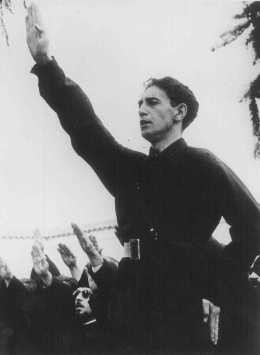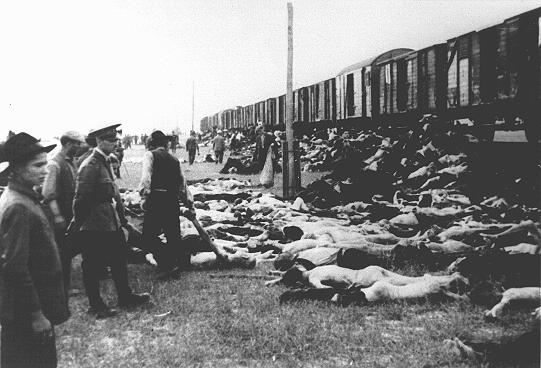Holocaust in Romania – US View
The treaties that followed World War I more than doubled the territory and population of Romania. The 1930 Romanian census recorded 728,115 persons who identified themselves as Jewish, comprising approximately 4 percent of the population.
By United States Holocaust Memorial Museum

Prewar photograph of students in a weaving workshop at a yeshiva (rabbinical academy) in the northern Transylvanian town of Sighet Marmatiei. Romania, prewar. — YIVO Institute for Jewish Research, New York
Traditionally, Romania had strong ties to France but tried (under its ruler King Carol II), to remain neutral in the 1930s. With the fall of France in June 1940, Nazi Germany supported the revisionist demands for Romanian territory of the Soviet Union, Hungary, and Bulgaria. During the summer and autumn of 1940, Romania lost about 30 percent of its territory and population. The Soviet Union demanded and received Bessarabia and northern Bukovina from Romania on June 28, 1940. On August 30, 1940, under German and Italian arbitration, Romania was forced to cede northern Transylvania to Hungary in the so-called Second Vienna Award. In September, Romania ceded southern Dobruja to Bulgaria.
Even before Romania fell into the orbit of Nazi Germany, Romanian authorities pursued a policy of harsh, persecutory antisemitism–particularly against Jews living in eastern borderlands, who were falsely associated with Soviet communism, and those living in Transylvania, who were identified with past Hungarian rule. Right-wing social revolutionary movements, like the fascist Iron Guard, found significant popular support and some official sympathy for their demand that the Jews of Romania be removed from alleged places of power and then expelled from Romania. However, their call for a social revolution against the political and economic establishment and their use of violent protest led to extreme hostility from the Romanian authorities. By 1938-1939, the Romanian police and the Iron Guard were locked in a state of virtual terrorist civil war.
THE “NATIONAL LEGIONARY STATE,” 1940-1941

Horia Sima, leader of the Iron Guard and deputy prime minister of the Romanian government in 1940. Bucharest, Romania, 1940. — Dokumentationsarchiv des Oesterreichischen Widerstandes
In September 1940, King Carol II was forced to abdicate after the loss of northern Transylvania to Hungary. A coalition government of radical right-wing military officers, under General Ion Antonescu and the Iron Guard, came to power and requested the dispatch of a German military mission to Romania. On November 20, 1940, Romania formally joined the Axis alliance.
The “National Legionary State” established by Antonescu and the Iron Guard quickly promulgated a number of restrictive measures against the Jews of Romania. In addition, Iron Guard thugs arbitrarily robbed or seized Jewish-owned businesses. They assaulted, and sometimes killed, Jewish citizens in the streets. Iron Guard confiscations and corruption threatened to disrupt the Romanian economy and led to tension with Antonescu and the Romanian army. The Iron Guard rose against the regime on January 21, 1941. During a three-day civil war, eventually won by Antonescu with support from the German army, members of the Iron Guard instigated a deadly pogrom in Bucharest, the capital city. Particularly gruesome was the murder of dozens of Jewish civilians in the Bucharest slaughterhouse. After the victims were killed, the perpetrators hung the bodies from meat hooks and mutilated them in a vicious parody of kosher slaughtering practices.
ROMANIA AND THE NAZI-SOVIET WAR, 1941-1944

During the deportation of survivors of a pogrom in Iasi to Calarasi or Podul Iloaei, Romanians halt a train to throw off the bodies of those who had died on the way. Romania, July 1941. — Historisches Archiv der Stadt Koln
Led by Antonescu, Romania participated fully in the German invasion of the Soviet Union in June 1941. Within days of the invasion, Romanian authorities staged a pogrom against the Jewish population in the city of Iasi, the regional capital of Moldavia. Romanian police officials shot hundreds of Jews in the courtyard of police headquarters. Hundreds more were killed on the streets or in their homes. In all, at least 4,000 Jews were murdered in Iasi during the pogrom. Thousands more were arrested, packed into freight cars, and deported by train to Calarasi and Podul Iloaei, towns located southwest of Iasi. Many of these deportees died en route from starvation or dehydration.
Following the invasion of the Soviet Union, Romania reannexed Bessarabia and northern Bukovina, which had been seized by the Soviets a year earlier. After the conquest of the Ukraine by German and Romanian troops in July and August 1941, Romania was given the territory between the Dniester and Bug Rivers. Romanian authorities established a military administration there and dubbed the region “Transnistria.”
Both in support of German SS and police units and on their own initiative, Romanian army and gendarmerie (police) personnel massacred thousands of Jews in Bessarabia, northern Bukovina, and Transnistria. Romanian and German units began systematic shootings of the Jewish residents of Kishinev, the capital of Bessarabia, shortly after occupying the city in July 1941. Survivors of the initial massacres, about 11,000 people, were herded into a ghetto and conscripted to perform forced labor under harsh conditions. In October, those left alive were deported to camps and ghettos in Transnistria, as were most of the surviving Jews in Bessarabia and northern Bukovina. Many Jews died of exposure, starvation, or disease during the deportations to Transnistria or after arrival. Others were murdered by Romanian or German units, either in Transnistria or after being driven across the Bug River into the German-occupied Ukraine.
Along the route from Iasi to either Calarasi or Podul IIoaei, Romanians remove corpses from a train carrying Jews deported from Iasi following a pogrom. Romania, late June or early July 1941. — Historisches Archiv der Stadt Koln
Romanian authorities established several de facto ghettos and two concentration camps in Transnistria. Among the most notorious of these ghettos (which the Romanians referred to as “colonies”) was Bogdanovka, on the west bank of the Bug River, where thousands of Jews were interned. In December 1941, Romanian troops, together with Ukrainian auxiliaries, massacred almost all the Jews in Bogdanovka; shootings continued for more than a week. The Romanians also massacred Jews in the Domanevka and Akhmetchetkha camps. Typhus-devastated Jews were crowded into the “colony” in Mogilev. Romanian authorities established concentration camps at Pechora and Vapniarka in Transnistria in the winter of 1941-1942. Vapniarka was reserved for Jewish political prisoners deported from Romania proper. Of its several thousand prisoners, very few were able to survive.
The Soviet army overran most of Transnistria in the spring of 1944. Bessarabia was conquered in the first weeks of the summer offensive. As Soviet troops massed on the Prut River, which separates Moldavia from Bessarabia, a group of opposition politicians, supported by King Michael, overthrew Antonescu and signed an armistice with the Soviet Union on August 23, 1944. Romanian troops then fought alongside Soviet troops through Hungary and into Germany.
Between 1941 and 1944, German and Romanian authorities murdered or caused the deaths of between 150,000 and 250,000 Romanian and Ukrainian Jews in Transnistria. At least 270,000 Romanian Jews were killed or died from mistreatment during the Holocaust.
Antonescu and several other officials of the Romanian wartime regime were tried after the war. Antonescu was convicted and executed. However, most Romanian perpetrators were never brought to justice.
—
Sursa
2010-10-05 05:28:25


